SEO
20 Essential Technical SEO Tools For Agencies

Technical SEO tools are plentiful.
However, tools are just part of the equation.
Tools are useless without an experienced technical SEO professional to guide the strategy and ensure successful results.
But, within the hands of an experienced professional, tools can do many wondrous things. From scaling a site’s SEO effortlessly to creating content, it’s possible to improve things with less effort (rather than more hard work).
Tools can increase efficiencies, including:
- Identifying issues on-site, like crawling and indexing.
- Diagnosing page speed issues.
- Identifying missing or duplicate text and other elements.
- Redirect issues.
- And many others.
Your SEO tools arsenal, and how you use them, can mean the difference between great success and failure.
And indeed, there is no shortage of technical SEO tools for agencies.
Here are a few of the best you should consider.
1. Screaming Frog
Screaming Frog is the crawler to have.
To create a substantial website audit, it is crucial to first perform a website crawl with this tool.
Depending on specific settings, it is possible to introduce false positives or errors into an audit that you otherwise would not know about.
Screaming Frog can help you identify the basics like:
- Missing page titles.
- Missing meta descriptions.
- Missing meta keywords.
- Large images.
- Errored response codes.
- Errors in URLs.
- Errors in canonicals.
Advanced things Screaming Frog can help you do include:
- Identifying issues with pagination.
- Diagnosing international SEO implementation issues.
- Taking a deep dive into a website’s architecture.
2. Google Search Console
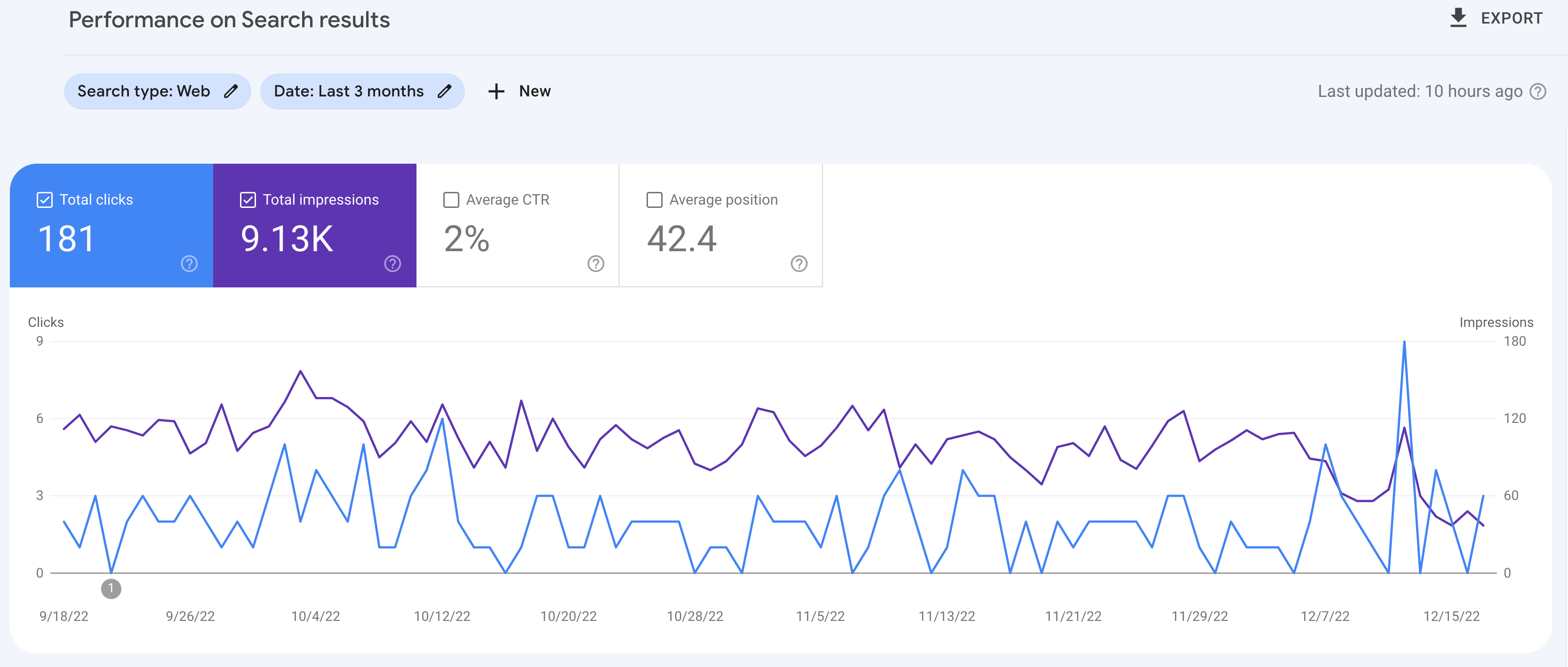 Screenshot from Google Search Console, December 2022
Screenshot from Google Search Console, December 2022The primary tool of any SEO pro should be the Google Search Console (GSC).
This critical tool has recently been overhauled to replace many old features while adding more data, features, and reports.
What makes this tool great for agencies? Setting up a reporting process.
For agencies that do SEO, good reporting is critical. If you have not already set up a reporting process, it is highly recommended that you do so.
This process can save you if you have an issue with website change-overs when GSC accounts can be wiped out. If your account is wiped out, it is possible to go back to all your GSC data, because you have been saving it for all these months.
Agency applications can also include utilizing the API for interfacing with other data usage as well.
3. Google Analytics
Where would we be without a solid analytics platform to analyze organic search performance?
While free, Google Analytics provides much in the way of information that can help you identify things like penalties, issues with traffic, and anything else that may come your way.
In much the same way as Google Search Console works, if you set up Google Analytics correctly, it’s ideal to have a monthly reporting process in place.
This process will help you save data for those situations where something unexpected happens to the client’s Google Analytics access.
At least, you won’t have a situation where you lose all data for your clients.
4. Web Developer Toolbar
 Screenshot from Web Developer Toolbar extension, December 2022
Screenshot from Web Developer Toolbar extension, December 2022The web developer toolbar extension for Google Chrome can be downloaded here.
It is an official port of the Firefox web developer extension.
One of the primary uses for this extension is identifying issues with code, specifically JavaScript implementations with menus and the user interface.
Turning off JavaScript and CSS makes it possible to identify where these issues are occurring in the browser.
Your auditing is not just limited to JavaScript and CSS issues.
You can also see alt text, find broken images, and view meta tag information and response headers.
5. WebPageTest
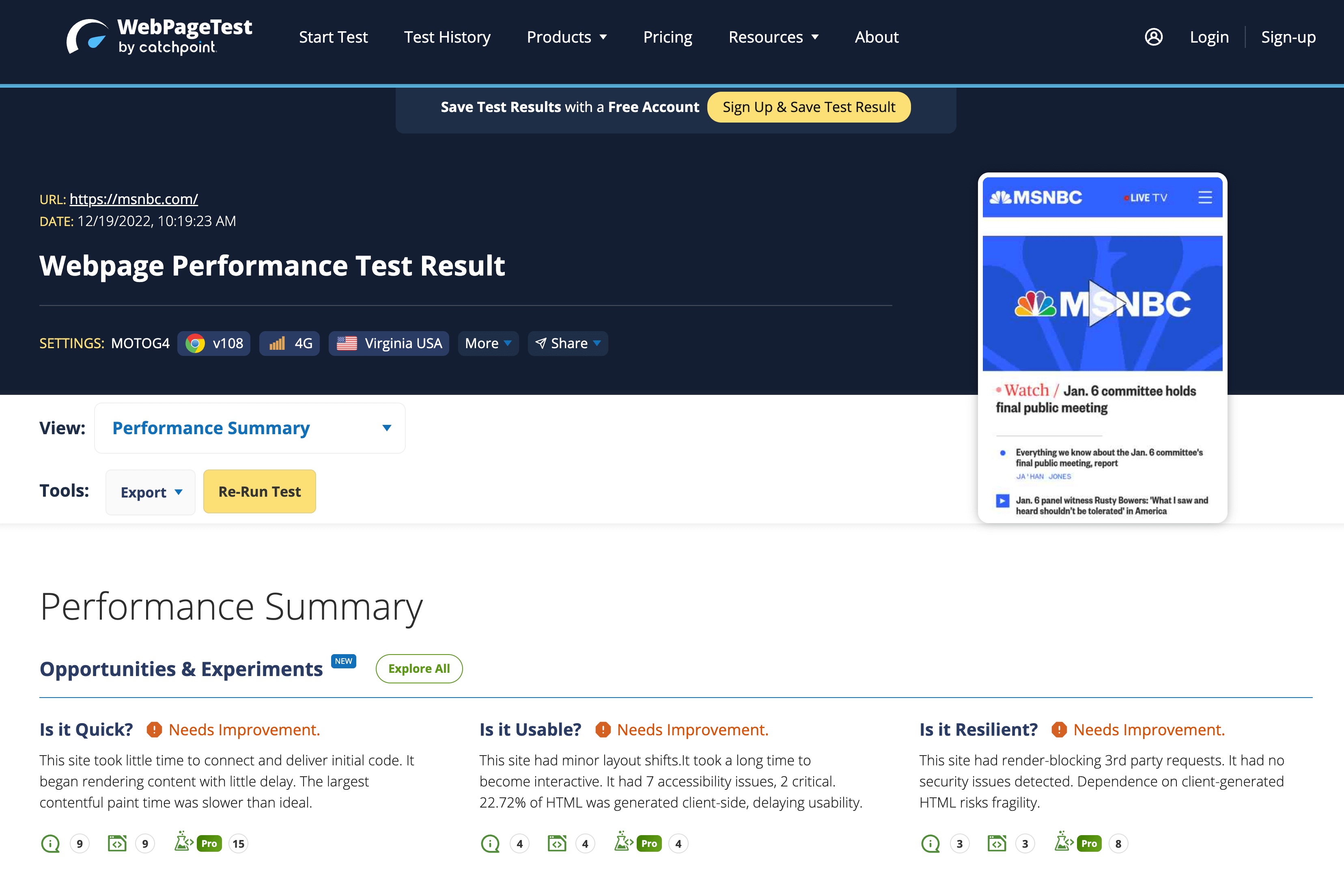 Screenshot of WebPageTest, December 2022
Screenshot of WebPageTest, December 2022Page speed has been a hot topic in recent years, and auditing website page speed brings you many useful tools.
To that end, WebPageTest is one of those essential SEO tools for your agency.
Cool things that you can do with WebPageTest include:
- Waterfall speed tests.
- Competitor speed tests.
- Competitor speed videos.
- Identifying how long it takes a site to load fully.
- Time to first byte.
- Start render time.
- Document object model (DOM) elements.
This is useful for determining how a site’s technical elements interact to create the final result or display time.
6. Google PageSpeed Insights
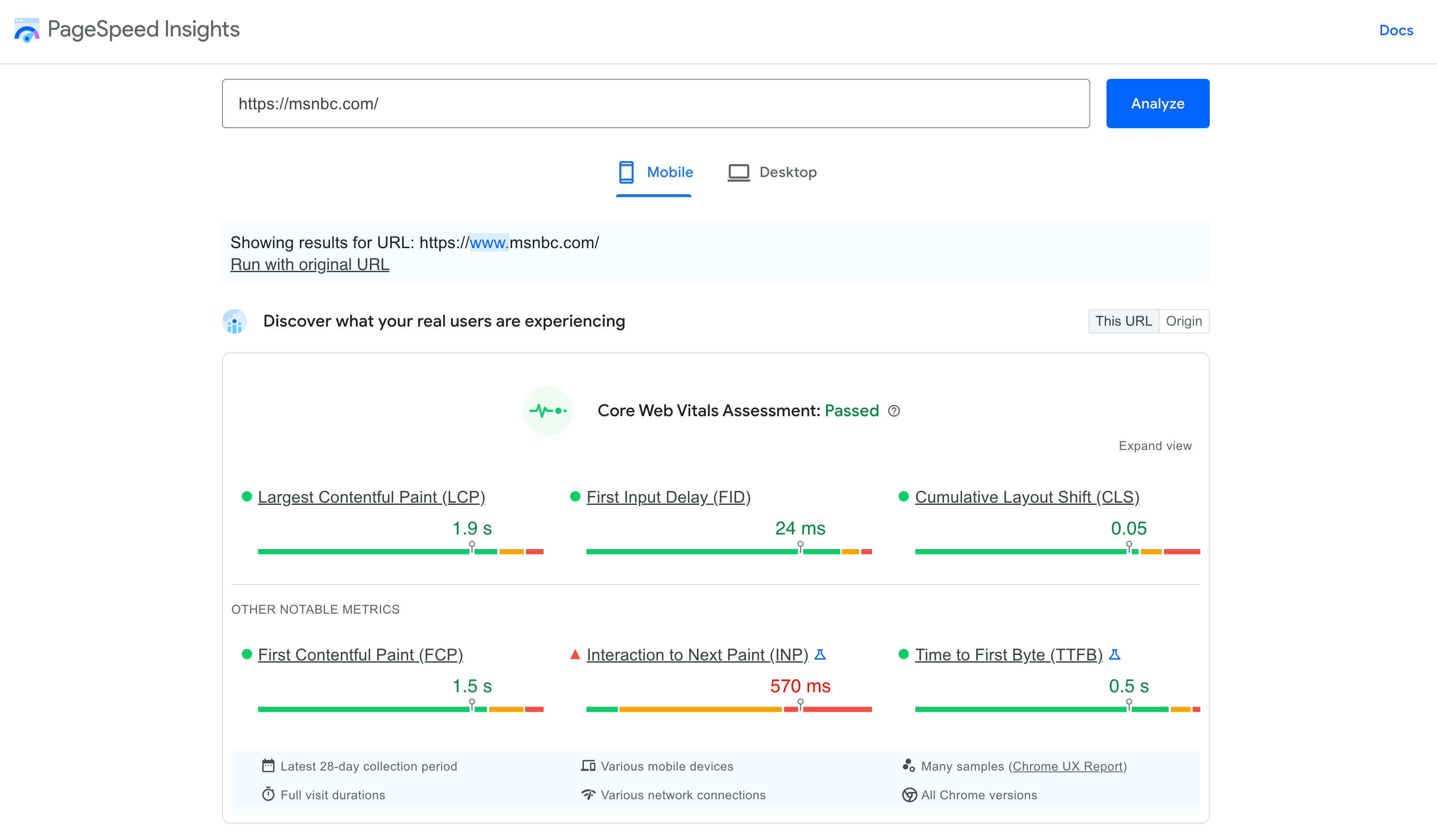 Screenshot of Google PageSpeed Insights, December 2022
Screenshot of Google PageSpeed Insights, December 2022Through a combination of speed metrics for both desktop and mobile, Google’s PageSpeed Insights is critical for agencies that want to get their website page speed ducks in a row.
It should not be used as the be-all, end-all of page metrics testing, but it is a good starting point.
Here’s why: PageSpeed Insights does not always use exact page speed. It uses approximations.
While you may get one result with Google PageSpeed, you may also get different results with other tools.
Remember that Google’s PageSpeed provides only part of the picture, and you need more complete data for an effective analysis. Use multiple tools for your analysis to get a full picture of your website’s performance.
7. Google Mobile-Friendly Testing Tool
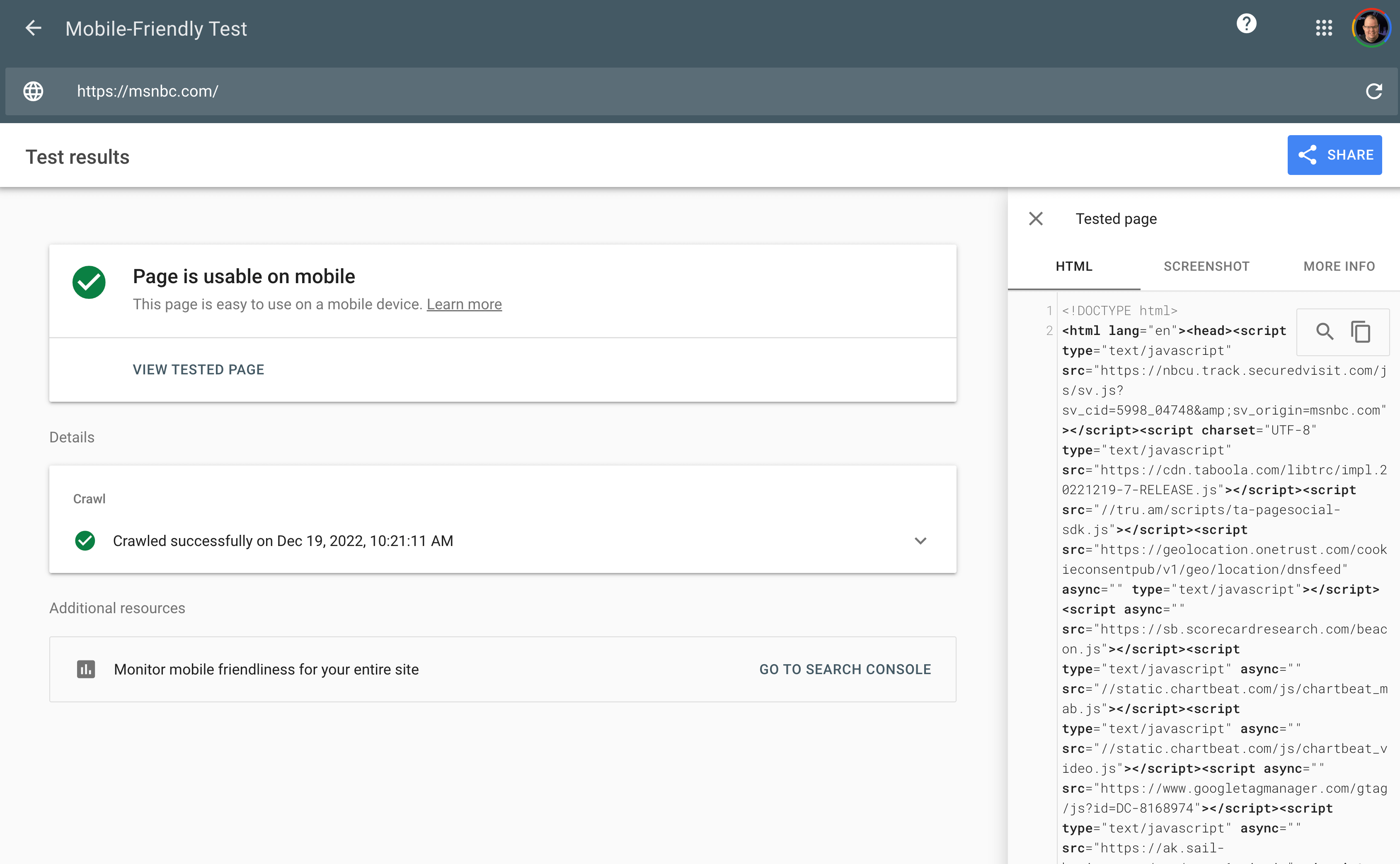 Screenshot of Google Mobile-Friendly Testing tool, December 2022
Screenshot of Google Mobile-Friendly Testing tool, December 2022Determining a website’s mobile technical aspects is also critical for any website audit.
When putting a website through its paces, Google’s Mobile-Friendly testing tool can give you insights into a website’s mobile implementation.
8. Google’s Rich Results Testing Tool
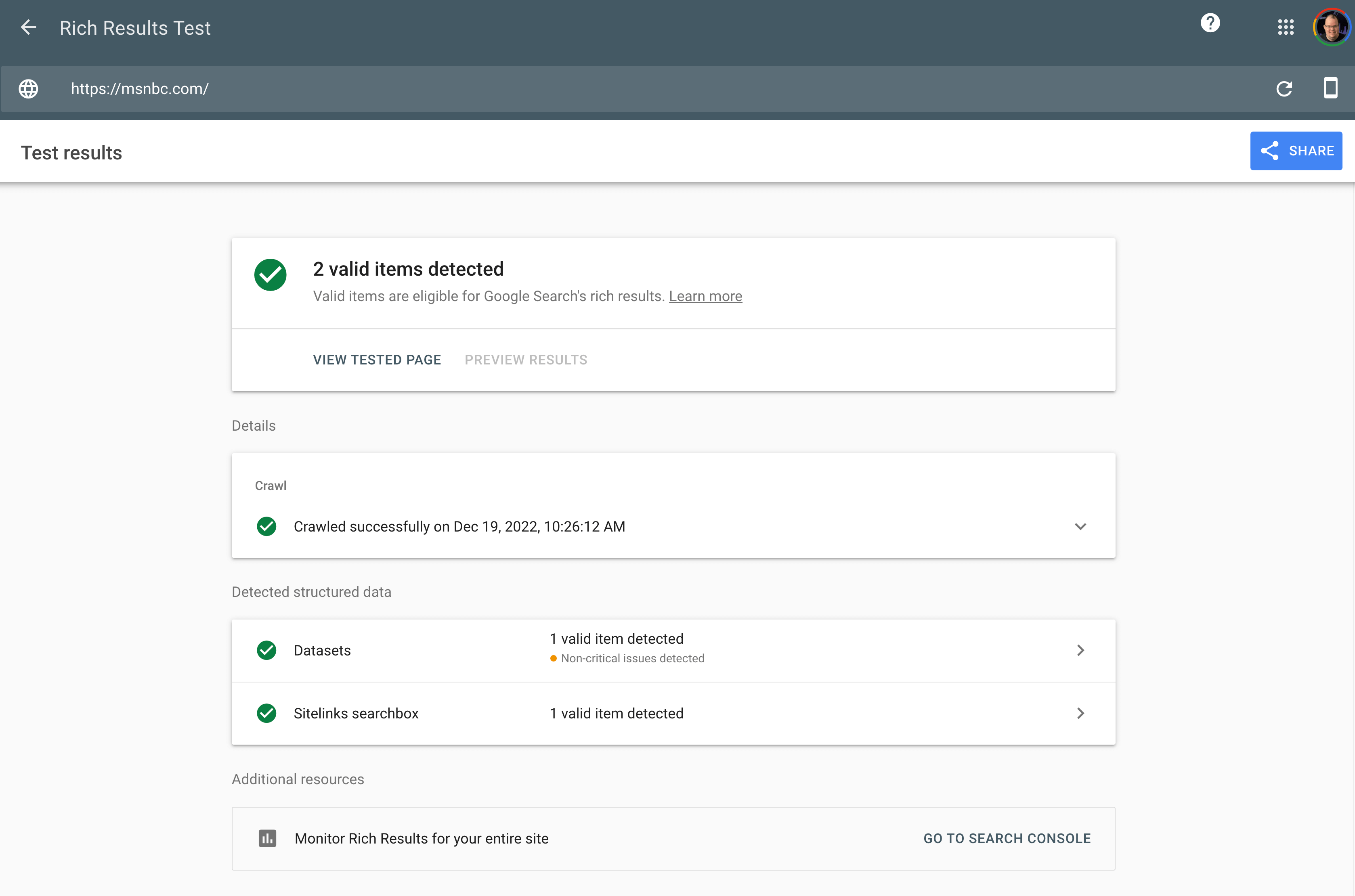
The Google Structured Data Testing Tool has been deprecated and replaced by the Google Rich Results Testing Tool.
This tool performs one function, and performs it well: it helps you test Schema structured data markup against the known data from Schema.org that Google supports.
This is a fantastic way to identify issues with your Schema coding before the code is implemented.
9. GTmetrix Page Speed Report
 Screenshot of GTmetrix, December 2022
Screenshot of GTmetrix, December 2022GTmetrix is a page speed report card that provides a different perspective on page speed.
By diving deep into page requests, CSS and JavaScript files that need to load, and other website elements, it is possible to clean up many elements that contribute to high page speed.
10. W3C Validator
 Screenshot of W3C Validator, December 2022
Screenshot of W3C Validator, December 2022You may not normally think of a code validator like W3C Validator as an SEO tool, but it is important just the same.
Be careful! If you don’t know what you are doing, it is easy to misinterpret the results and actually make things worse.
For example, say you are validating code from a site that was developed in XHTML, but the code was ported over to WordPress.
Copying and pasting the entire code into WordPress during development does not change its document type automatically. If during testing, you run across pages that have thousands of errors across the entire document, that is likely why.
A website that was developed in this fashion is more likely to need a complete overhaul with new code, especially if the former code does not exist.
11. Semrush
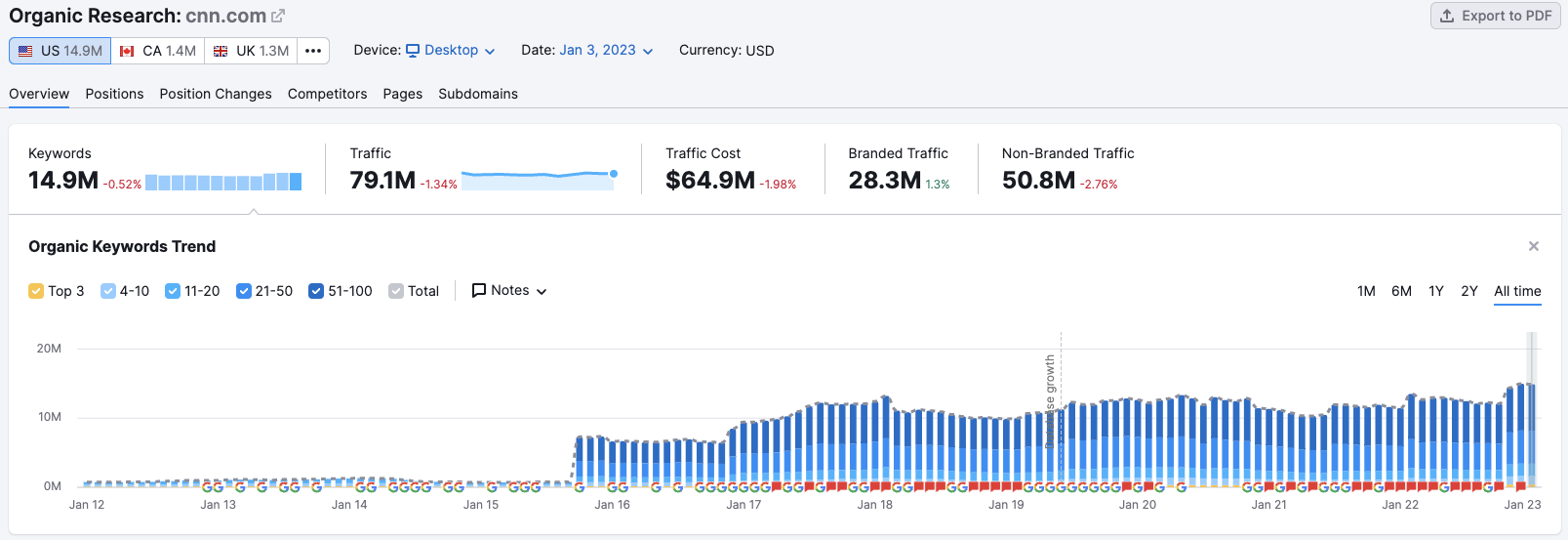 Screenshot of Semrush, January 2022
Screenshot of Semrush, January 2022Semrush’s greatest claim to fame is accurate data for keyword research and other technical research.
But what makes Semrush so valuable is its competitor analysis data.
You may not normally think of Semrush as a technical analysis tool.
However, if you go deep enough into a competitor analysis, the rankings data and market analysis data can reveal surprising information.
You can use these insights to better tailor your SEO strategy and gain an edge over your competitors.
12. Ahrefs
 Screenshot of Ahrefs, January 2022
Screenshot of Ahrefs, January 2022Ahrefs is considered by many to be a tool that is a critical component of modern technical link analysis.
By identifying certain patterns in a website’s link profile, you can figure out what a site is doing for its linking strategy.
It is possible to identify anchor text issues that may be impacting a site using its word cloud feature.
Also, you can identify the types of links linking back to the site – whether it’s a blog network, a high-risk link profile with many forum and Web 2.0 links, or other major issues.
Other abilities include identifying when a site’s backlinks started going missing, its linking patterns, and much more.
13. Majestic
Majestic is a long-standing tool in the SEO industry with unique linking insights.
Like Ahrefs, you can identify things like linking patterns by downloading reports of the site’s full link profile.
It is also possible to find things like bad neighborhoods and other domains a website owner owns.
Using this bad neighborhood report, you can diagnose issues with a site’s linking arising out of issues with the site’s website associations.
Like most tools, Majestic has its own values for calculating technical link attributes like Trust Flow, Citation Flow, and other linking elements contributing to trust, relevance, and authority.
It is also possible through its own link graphs to identify any issues occurring with the link profile over time.
Majestic is an exceptional tool in your link diagnostic process.
14. Moz Bar
It is hard to think of something like the MozBar, which lends itself to a little bit of whimsicality, as a serious technical SEO tool. But, there are many metrics that you can gain from detailed analysis.
Things like Moz’s Domain Authority and Page Authority, Google Caching status, other code like social open graph coding, and neat things like the page Metas at-a-glance while in the web browser.
Without diving deep into a crawl, you can also see other advanced elements like rel=”canonical” tags, page load time, Schema Markup, and even the page’s HTTP status.
This is useful for an initial survey of the site before diving deeper into a proper audit, and it can be a good idea to include the findings from this data in an actual audit.
15. Barracuda Panguin
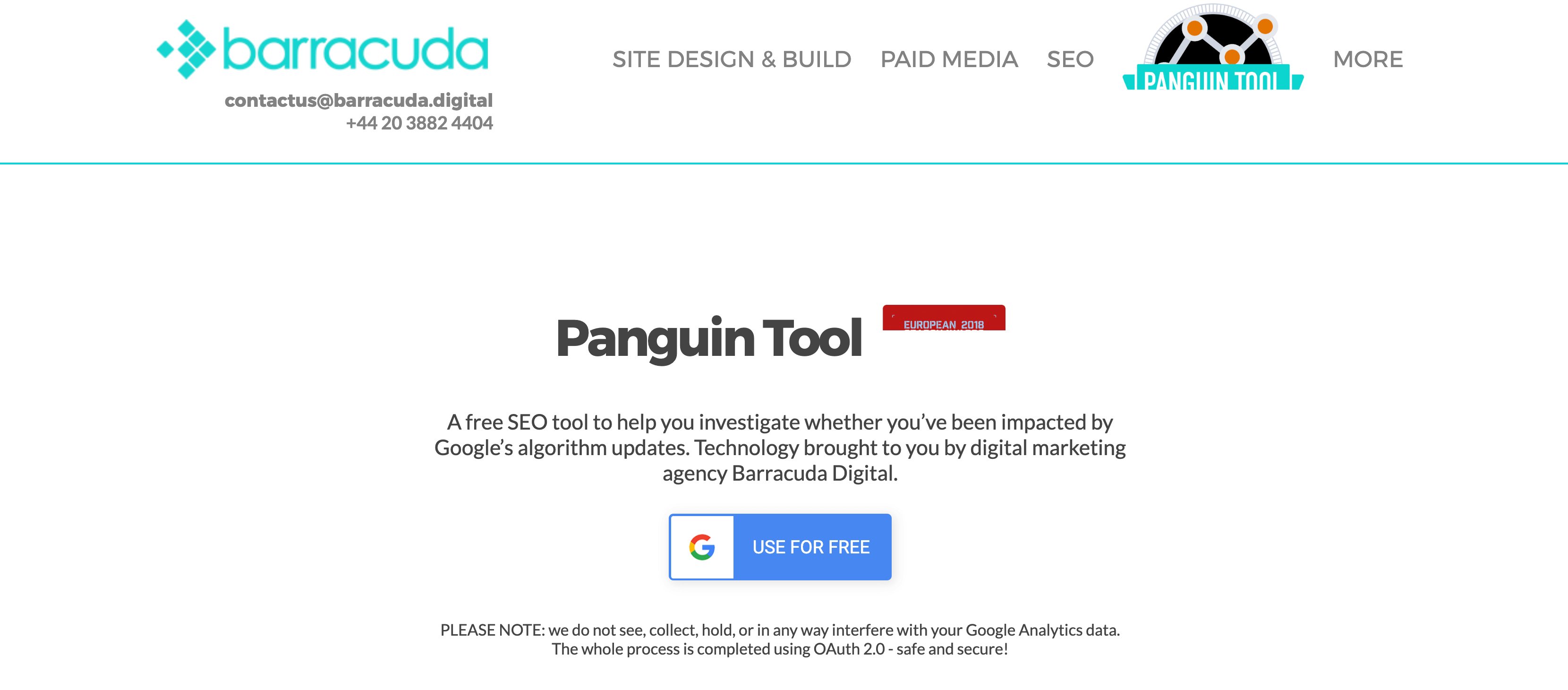 Screenshot of Barracuda Panguin Tool, December 2022
Screenshot of Barracuda Panguin Tool, December 2022If you are investigating a site for a penalty, the Barracuda Panguin tool should be a part of your workflow.
It works by connecting to the Google Analytics account of the site you are investigating. The overlay is intertwined with the GA data, and it will overlay data of when a penalty occurred with your GA data.
Using this overlay, it is possible to easily identify situations where potential penalties occur.
Now, it is important to note that there isn’t an exact science to this, and that correlation isn’t always causation.
It’s important to investigate all avenues of where data is potentially showing something happening, in order to rule out any potential penalty.
Using tools like this can help you zero in on approximations in data events as they occur, which can help for investigative reasons.
16. Google Search Console XML Sitemap Report
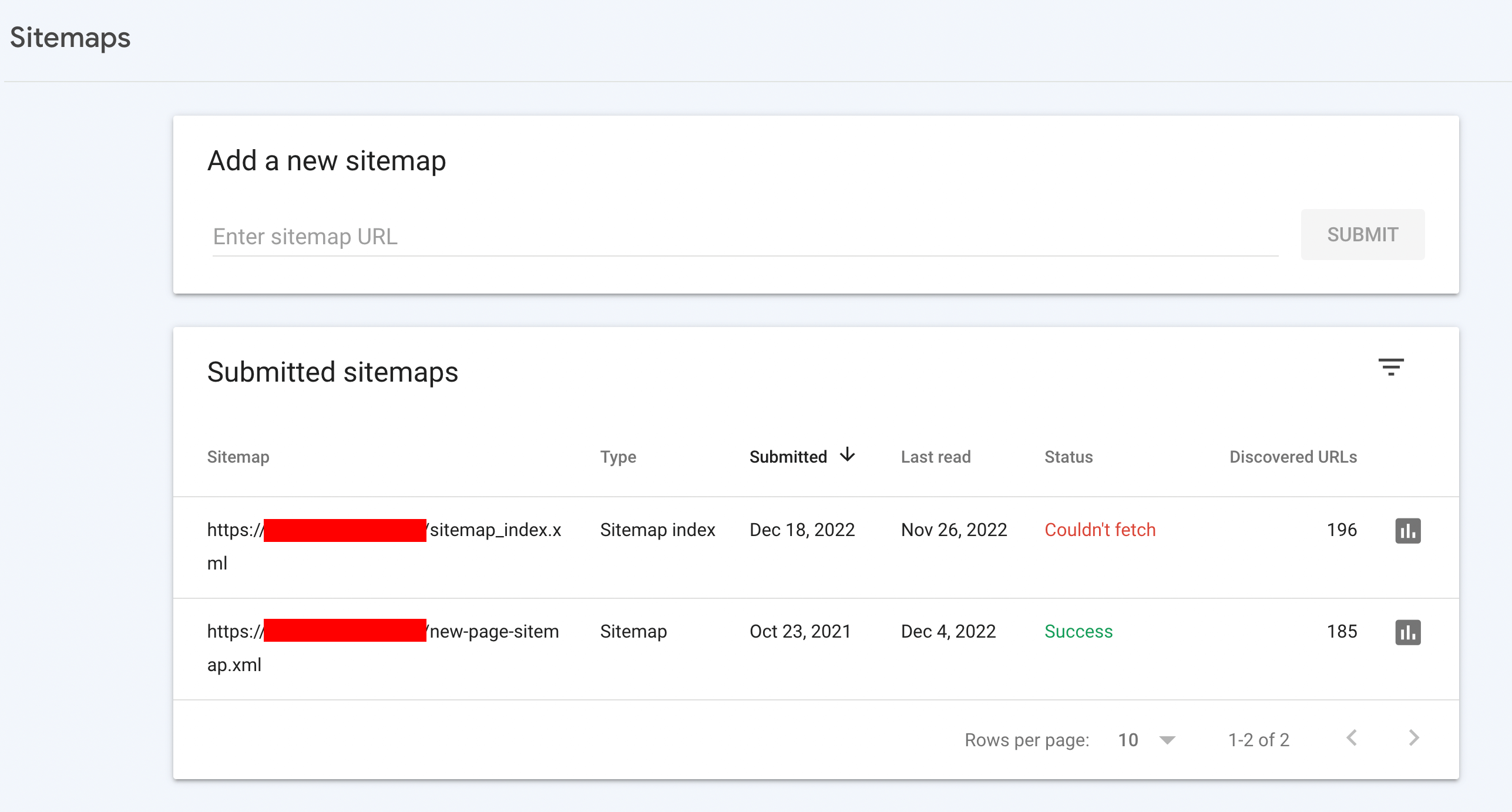 Screenshot of Google Search Console XML Sitemap, December 2022
Screenshot of Google Search Console XML Sitemap, December 2022The Google Search Console XML Sitemap Report is one of those technical SEO tools that should be an important part of any agency’s reporting workflow.
Diagnosing sitemap issues is a critical part of any SEO audit, and this technical insight can help you achieve the all-important 1:1 ratio of URLs added to the site and the sitemap being updated.
For those who don’t know, it is considered an SEO best practice to ensure the following:
- That a sitemap is supposed to contain all 200 OK URLs. No 4xx or 5xx URLs should be showing up in the sitemap.
- There should be a 1:1 ratio of exact URLs in the sitemap as there are on the site. In other words, the sitemap should not have any orphaned pages that are not showing up in the Screaming Frog crawl.
- Any parameter-laden URLs should be removed from the sitemap if they are not considered primary pages. Certain parameters will cause issues with XML sitemaps validating, so make sure that these parameters are not included in URLs.
17. BrightLocal
If you are operating a website for a local business, your SEO strategy should involve local SEO for a significant portion of its link acquisition efforts.
This is where BrightLocal comes in.
It is normally not thought of as a technical SEO tool, but its application can help you uncover technical issues with the site’s local SEO profile.
For example, you can audit the site’s local SEO citations with this tool. Then, you can move forward with identifying and submitting your site to the appropriate citations.
It works kind of like Yext, in that it has a pre-populated list of potential citations.
One of BrightLocal’s essential tools is that it lets you audit, clean, and build citations to the most common citation sites (and others that are less common).
BrightLocal also includes in-depth auditing of your Google Business Profile presence, including in-depth local SEO audits.
If your agency is heavy into local SEO, this is one of those tools that is a no-brainer, from a workflow perspective.
18. Whitespark
Whitespark is more in-depth when compared to BrightLocal.
Its local citation finder allows you to dive deeper into your site’s local SEO by finding where your site is across the competitor space.
To that end, it also lets you identify all of your competitor’s local SEO citations.
In addition, part of its auditing capabilities allows it to track rankings through detailed reporting focused on distinct Google local positions such as the local pack and local finder, as well as detailed organic rankings reports from both Google and Bing.
19. Botify
Botify is one of the most complete technical SEO tools available.
Its claim to fame includes the ability to reconcile search intent and technical SEO with its in-depth keywords analysis tool. You can tie things like crawl budget and technical SEO elements that map to searcher intent.
Not only that, but it’s also possible to identify all the technical SEO factors that are contributing to ranking through Botify’s detailed technical analysis.
In its detailed reporting, you can also use the tool to detect changes in how people are searching, regardless of the industry that you are focused on.
The powerful part of Botify includes its in-depth reports that are capable of tying data to information that you can really act on.
20. Excel
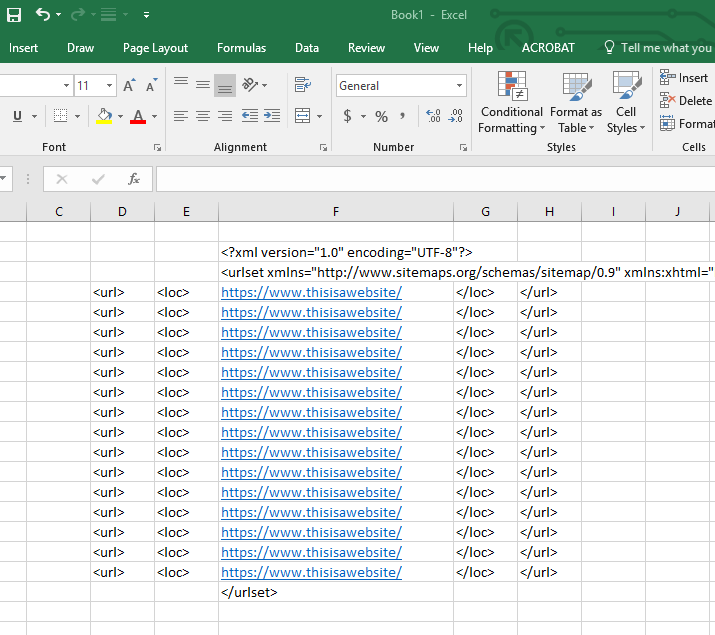 Screenshot by author, December 2022
Screenshot by author, December 2022Many SEO pros aren’t aware that Excel can be considered a technical SEO tool.
Surprising, right?
Well, there are a number of Excel super tricks that one can use to perform technical SEO audits. Tasks that would otherwise take a significantly long time manually can be accomplished much faster.
Let’s look at a few of these “super tricks.”
Super Trick #1: VLOOKUP
With VLOOKUP, it is possible to pull data from multiple sheets based on data that you want to populate in the primary sheet.
This function allows you to do things like perform a link analysis using data gathered from different tools.
If you gathered linking data from GSC’s “who links to you the most” report, other data from Ahrefs, and other data from Moz, you know that it is impossible to reconcile all the information together.
What if you wanted to determine which internal links are valuable in accordance with a site’s inbound linking strategy?
Using this VLOOKUP video, you can combine data from GSC’s report with data from Ahrefs’ report to get the entire picture of what’s happening here.
Super Trick #2: Easy XML Sitemaps
Coding XML Sitemaps manually is a pain, isn’t it?
Not anymore.
Using a process of coding that is implemented quickly, it is possible to code a sitemap in Excel in a matter of minutes – if you work smart.
See the video I created showing this process.
Super Trick #3: Conditional Formatting
Using conditional formatting, it is possible to reconcile long lists of information in Excel.
This is useful in many SEO situations where lists of information are compared daily.
Although Tools Create Efficiencies, They Do Not Replace Manual Work
For any SEO agency that wants a competitive edge, SEO tools run the gamut from crawling to auditing, data gathering, analysis, and much more.
You don’t want to leave your results up to chance.
The right tools can provide another dimension to your analysis that standard analysis might otherwise not provide.
They can also give you an edge in creating an output that will delight your clients and keep them coming back for years to come.
Which of these tools will you use to wow your customers?
Featured Image: Paulo Bobita/Search Engine Journal
SEO
How To Use ChatGPT For Keyword Research

Anyone not using ChatGPT for keyword research is missing a trick.
You can save time and understand an entire topic in seconds instead of hours.
In this article, I outline my most effective ChatGPT prompts for keyword research and teach you how I put them together so that you, too, can take, edit, and enhance them even further.
But before we jump into the prompts, I want to emphasize that you shouldn’t replace keyword research tools or disregard traditional keyword research methods.
ChatGPT can make mistakes. It can even create new keywords if you give it the right prompt. For example, I asked it to provide me with a unique keyword for the topic “SEO” that had never been searched before.
“Interstellar Internet SEO: Optimizing content for the theoretical concept of an interstellar internet, considering the challenges of space-time and interplanetary communication delays.”
Although I want to jump into my LinkedIn profile and update my title to “Interstellar Internet SEO Consultant,” unfortunately, no one has searched that (and they probably never will)!
You must not blindly rely on the data you get back from ChatGPT.
What you can rely on ChatGPT for is the topic ideation stage of keyword research and inspiration.
ChatGPT is a large language model trained with massive amounts of data to accurately predict what word will come next in a sentence. However, it does not know how to do keyword research yet.
Instead, think of ChatGPT as having an expert on any topic armed with the information if you ask it the right question.
In this guide, that is exactly what I aim to teach you how to do – the most essential prompts you need to know when performing topical keyword research.
Best ChatGPT Keyword Research Prompts
The following ChatGPT keyword research prompts can be used on any niche, even a topic to which you are brand new.
For this demonstration, let’s use the topic of “SEO” to demonstrate these prompts.
Generating Keyword Ideas Based On A Topic
What Are The {X} Most Popular Sub-topics Related To {Topic}?
The first prompt is to give you an idea of the niche.
As shown above, ChatGPT did a great job understanding and breaking down SEO into three pillars: on-page, off-page & technical.
The key to the following prompt is to take one of the topics ChatGPT has given and query the sub-topics.
What Are The {X} Most Popular Sub-topics Related To {Sub-topic}?
For this example, let’s query, “What are the most popular sub-topics related to keyword research?”
Having done keyword research for over 10 years, I would expect it to output information related to keyword research metrics, the types of keywords, and intent.
Let’s see.
 Screenshot from ChatGPT 4, April 2024
Screenshot from ChatGPT 4, April 2024Again, right on the money.
To get the keywords you want without having ChatGPT describe each answer, use the prompt “list without description.”
Here is an example of that.
List Without Description The Top {X} Most Popular Keywords For The Topic Of {X}
You can even branch these keywords out further into their long-tail.
Example prompt:
List Without Description The Top {X} Most Popular Long-tail Keywords For The Topic “{X}”
 Screenshot ChatGPT 4,April 2024
Screenshot ChatGPT 4,April 2024List Without Description The Top Semantically Related Keywords And Entities For The Topic {X}
You can even ask ChatGPT what any topic’s semantically related keywords and entities are!
 Screenshot ChatGPT 4, April 2024
Screenshot ChatGPT 4, April 2024Tip: The Onion Method Of Prompting ChatGPT
When you are happy with a series of prompts, add them all to one prompt. For example, so far in this article, we have asked ChatGPT the following:
- What are the four most popular sub-topics related to SEO?
- What are the four most popular sub-topics related to keyword research
- List without description the top five most popular keywords for “keyword intent”?
- List without description the top five most popular long-tail keywords for the topic “keyword intent types”?
- List without description the top semantically related keywords and entities for the topic “types of keyword intent in SEO.”
Combine all five into one prompt by telling ChatGPT to perform a series of steps. Example:
“Perform the following steps in a consecutive order Step 1, Step 2, Step 3, Step 4, and Step 5”
Example:
“Perform the following steps in a consecutive order Step 1, Step 2, Step 3, Step 4 and Step 5. Step 1 – Generate an answer for the 3 most popular sub-topics related to {Topic}?. Step 2 – Generate 3 of the most popular sub-topics related to each answer. Step 3 – Take those answers and list without description their top 3 most popular keywords. Step 4 – For the answers given of their most popular keywords, provide 3 long-tail keywords. Step 5 – for each long-tail keyword offered in the response, a list without descriptions 3 of their top semantically related keywords and entities.”
Generating Keyword Ideas Based On A Question
Taking the steps approach from above, we can get ChatGPT to help streamline getting keyword ideas based on a question. For example, let’s ask, “What is SEO?”
“Perform the following steps in a consecutive order Step 1, Step 2, Step 3, and Step 4. Step 1 Generate 10 questions about “{Question}”?. Step 2 – Generate 5 more questions about “{Question}” that do not repeat the above. Step 3 – Generate 5 more questions about “{Question}” that do not repeat the above. Step 4 – Based on the above Steps 1,2,3 suggest a final list of questions avoiding duplicates or semantically similar questions.”
 Screenshot ChatGPT 4, April 2024
Screenshot ChatGPT 4, April 2024Generating Keyword Ideas Using ChatGPT Based On The Alphabet Soup Method
One of my favorite methods, manually, without even using a keyword research tool, is to generate keyword research ideas from Google autocomplete, going from A to Z.
-
 Screenshot from Google autocomplete, April 2024
Screenshot from Google autocomplete, April 2024
You can also do this using ChatGPT.
Example prompt:
“give me popular keywords that includes the keyword “SEO”, and the next letter of the word starts with a”
 Screenshot from ChatGPT 4, April 2024
Screenshot from ChatGPT 4, April 2024Tip: Using the onion prompting method above, we can combine all this in one prompt.
“Give me five popular keywords that include “SEO” in the word, and the following letter starts with a. Once the answer has been done, move on to giving five more popular keywords that include “SEO” for each letter of the alphabet b to z.”
Generating Keyword Ideas Based On User Personas
When it comes to keyword research, understanding user personas is essential for understanding your target audience and keeping your keyword research focused and targeted. ChatGPT may help you get an initial understanding of customer personas.
Example prompt:
“For the topic of “{Topic}” list 10 keywords each for the different types of user personas”
 Screenshot from ChatGPT 4, April 2024
Screenshot from ChatGPT 4, April 2024You could even go a step further and ask for questions based on those topics that those specific user personas may be searching for:
 Screenshot ChatGPT 4, April 2024
Screenshot ChatGPT 4, April 2024As well as get the keywords to target based on those questions:
“For each question listed above for each persona, list the keywords, as well as the long-tail keywords to target, and put them in a table”
 Screenshot from ChatGPT 4, April 2024
Screenshot from ChatGPT 4, April 2024Generating Keyword Ideas Using ChatGPT Based On Searcher Intent And User Personas
Understanding the keywords your target persona may be searching is the first step to effective keyword research. The next step is to understand the search intent behind those keywords and which content format may work best.
For example, a business owner who is new to SEO or has just heard about it may be searching for “what is SEO.”
However, if they are further down the funnel and in the navigational stage, they may search for “top SEO firms.”
You can query ChatGPT to inspire you here based on any topic and your target user persona.
SEO Example:
“For the topic of “{Topic}” list 10 keywords each for the different types of searcher intent that a {Target Persona} would be searching for”
ChatGPT For Keyword Research Admin
Here is how you can best use ChatGPT for keyword research admin tasks.
Using ChatGPT As A Keyword Categorization Tool
One of the use cases for using ChatGPT is for keyword categorization.
In the past, I would have had to devise spreadsheet formulas to categorize keywords or even spend hours filtering and manually categorizing keywords.
ChatGPT can be a great companion for running a short version of this for you.
Let’s say you have done keyword research in a keyword research tool, have a list of keywords, and want to categorize them.
You could use the following prompt:
“Filter the below list of keywords into categories, target persona, searcher intent, search volume and add information to a six-column table: List of keywords – [LIST OF KEYWORDS], Keyword Search Volume [SEARCH VOLUMES] and Keyword Difficulties [KEYWORD DIFFICUTIES].”
-
 Screenshot from ChatGPT, April 2024
Screenshot from ChatGPT, April 2024
Tip: Add keyword metrics from the keyword research tools, as using the search volumes that a ChatGPT prompt may give you will be wildly inaccurate at best.
Using ChatGPT For Keyword Clustering
Another of ChatGPT’s use cases for keyword research is to help you cluster. Many keywords have the same intent, and by grouping related keywords, you may find that one piece of content can often target multiple keywords at once.
However, be careful not to rely only on LLM data for clustering. What ChatGPT may cluster as a similar keyword, the SERP or the user may not agree with. But it is a good starting point.
The big downside of using ChatGPT for keyword clustering is actually the amount of keyword data you can cluster based on the memory limits.
So, you may find a keyword clustering tool or script that is better for large keyword clustering tasks. But for small amounts of keywords, ChatGPT is actually quite good.
A great use small keyword clustering use case using ChatGPT is for grouping People Also Ask (PAA) questions.
Use the following prompt to group keywords based on their semantic relationships. For example:
“Organize the following keywords into groups based on their semantic relationships, and give a short name to each group: [LIST OF PAA], create a two-column table where each keyword sits on its own row.
-
 Screenshot from ChatGPT, April 2024
Screenshot from ChatGPT, April 2024
Using Chat GPT For Keyword Expansion By Patterns
One of my favorite methods of doing keyword research is pattern spotting.
Most seed keywords have a variable that can expand your target keywords.
Here are a few examples of patterns:
1. Question Patterns
(who, what, where, why, how, are, can, do, does, will)
“Generate [X] keywords for the topic “[Topic]” that contain any or all of the following “who, what, where, why, how, are, can, do, does, will”
 Screenshot ChatGPT 4, April 2024
Screenshot ChatGPT 4, April 20242. Comparison Patterns
Example:
“Generate 50 keywords for the topic “{Topic}” that contain any or all of the following “for, vs, alternative, best, top, review”
 Screenshot ChatGPT 4, April 2024
Screenshot ChatGPT 4, April 20243. Brand Patterns
Another one of my favorite modifiers is a keyword by brand.
We are probably all familiar with the most popular SEO brands; however, if you aren’t, you could ask your AI friend to do the heavy lifting.
Example prompt:
“For the top {Topic} brands what are the top “vs” keywords”
 Screenshot ChatGPT 4, April 2024
Screenshot ChatGPT 4, April 20244. Search Intent Patterns
One of the most common search intent patterns is “best.”
When someone is searching for a “best {topic}” keyword, they are generally searching for a comprehensive list or guide that highlights the top options, products, or services within that specific topic, along with their features, benefits, and potential drawbacks, to make an informed decision.
Example:
“For the topic of “[Topic]” what are the 20 top keywords that include “best”
 Screenshot ChatGPT 4, April 2024
Screenshot ChatGPT 4, April 2024Again, this guide to keyword research using ChatGPT has emphasized the ease of generating keyword research ideas by utilizing ChatGPT throughout the process.
Keyword Research Using ChatGPT Vs. Keyword Research Tools
Free Vs. Paid Keyword Research Tools
Like keyword research tools, ChatGPT has free and paid options.
However, one of the most significant drawbacks of using ChatGPT for keyword research alone is the absence of SEO metrics to help you make smarter decisions.
To improve accuracy, you could take the results it gives you and verify them with your classic keyword research tool – or vice versa, as shown above, uploading accurate data into the tool and then prompting.
However, you must consider how long it takes to type and fine-tune your prompt to get your desired data versus using the filters within popular keyword research tools.
For example, if we use a popular keyword research tool using filters, you could have all of the “best” queries with all of their SEO metrics:
-
 Screenshot from Ahrefs Keyword Explorer, March 2024
Screenshot from Ahrefs Keyword Explorer, March 2024
And unlike ChatGPT, generally, there is no token limit; you can extract several hundred, if not thousands, of keywords at a time.
As I have mentioned multiple times throughout this piece, you cannot blindly trust the data or SEO metrics it may attempt to provide you with.
The key is to validate the keyword research with a keyword research tool.
ChatGPT For International SEO Keyword Research
ChatGPT can be a terrific multilingual keyword research assistant.
For example, if you wanted to research keywords in a foreign language such as French. You could ask ChatGPT to translate your English keywords;
 Screenshot ChatGPT 4, Apil 2024
Screenshot ChatGPT 4, Apil 2024- The key is to take the data above and paste it into a popular keyword research tool to verify.
- As you can see below, many of the keyword translations for the English keywords do not have any search volume for direct translations in French.
 Screenshot from Ahrefs Keyword Explorer, April 2024
Screenshot from Ahrefs Keyword Explorer, April 2024But don’t worry, there is a workaround: If you have access to a competitor keyword research tool, you can see what webpage is ranking for that query – and then identify the top keyword for that page based on the ChatGPT translated keywords that do have search volume.
-
-
 Screenshot from Ahrefs Keyword Explorer, April 2024
Screenshot from Ahrefs Keyword Explorer, April 2024
Or, if you don’t have access to a paid keyword research tool, you could always take the top-performing result, extract the page copy, and then ask ChatGPT what the primary keyword for the page is.
Key Takeaway
-
ChatGPT can be an expert on any topic and an invaluable keyword research tool. However, it is another tool to add to your toolbox when doing keyword research; it does not replace traditional keyword research tools.
As shown throughout this tutorial, from making up keywords at the beginning to inaccuracies around data and translations, ChatGPT can make mistakes when used for keyword research.
You cannot blindly trust the data you get back from ChatGPT.
However, it can offer a shortcut to understanding any topic for which you need to do keyword research and, as a result, save you countless hours.
But the key is how you prompt.
The prompts I shared with you above will help you understand a topic in minutes instead of hours and allow you to better seed keywords using keyword research tools.
It can even replace mundane keyword clustering tasks that you used to do with formulas in spreadsheets or generate ideas based on keywords you give it.
Paired with traditional keyword research tools, ChatGPT for keyword research can be a powerful tool in your arsenal.
More resources:
Featured Image: Tatiana Shepeleva/Shutterstock
SEO
OpenAI Expected to Integrate Real-Time Data In ChatGPT

Sam Altman, CEO of OpenAI, dispelled rumors that a new search engine would be announced on Monday, May 13. Recent deals have raised the expectation that OpenAI will announce the integration of real-time content from English, Spanish, and French publications into ChatGPT, complete with links to the original sources.
OpenAI Search Is Not Happening
Many competing search engines have tried and failed to challenge Google as the leading search engine. A new wave of hybrid generative AI search engines is currently trying to knock Google from the top spot with arguably very little success.
Sam Altman is on record saying that creating a search engine to compete against Google is not a viable approach. He suggested that technological disruption was the way to replace Google by changing the search paradigm altogether. The speculation that Altman is going to announce a me-too search engine on Monday never made sense given his recent history of dismissing the concept as a non-starter.
So perhaps it’s not a surprise that he recently ended the speculation by explicitly saying that he will not be announcing a search engine on Monday.
He tweeted:
“not gpt-5, not a search engine, but we’ve been hard at work on some new stuff we think people will love! feels like magic to me.”
“New Stuff” May Be Iterative Improvement
It’s quite likely that what’s going to be announced is iterative which means it improves ChatGPT but not replaces it. This fits into how Altman recently expressed his approach with ChatGPT.
He remarked:
“And it does kind of suck to ship a product that you’re embarrassed about, but it’s much better than the alternative. And in this case in particular, where I think we really owe it to society to deploy iteratively.
There could totally be things in the future that would change where we think iterative deployment isn’t such a good strategy, but it does feel like the current best approach that we have and I think we’ve gained a lot from from doing this and… hopefully the larger world has gained something too.”
Improving ChatGPT iteratively is Sam Altman’s preference and recent clues point to what those changes may be.
Recent Deals Contain Clues
OpenAI has been making deals with news media and User Generated Content publishers since December 2023. Mainstream media has reported these deals as being about licensing content for training large language models. But they overlooked a a key detail that we reported on last month which is that these deals give OpenAI access to real-time information that they stated will be used to give attribution to that real-time data in the form of links.
That means that ChatGPT users will gain the ability to access real-time news and to use that information creatively within ChatGPT.
Dotdash Meredith Deal
Dotdash Meredith (DDM) is the publisher of big brand publications such as Better Homes & Gardens, FOOD & WINE, InStyle, Investopedia, and People magazine. The deal that was announced goes way beyond using the content as training data. The deal is explicitly about surfacing the Dotdash Meredith content itself in ChatGPT.
The announcement stated:
“As part of the agreement, OpenAI will display content and links attributed to DDM in relevant ChatGPT responses. …This deal is a testament to the great work OpenAI is doing on both fronts to partner with creators and publishers and ensure a healthy Internet for the future.
Over 200 million Americans each month trust our content to help them make decisions, solve problems, find inspiration, and live fuller lives. This partnership delivers the best, most relevant content right to the heart of ChatGPT.”
A statement from OpenAI gives credibility to the speculation that OpenAI intends to directly show licensed third-party content as part of ChatGPT answers.
OpenAI explained:
“We’re thrilled to partner with Dotdash Meredith to bring its trusted brands to ChatGPT and to explore new approaches in advancing the publishing and marketing industries.”
Something that DDM also gets out of this deal is that OpenAI will enhance DDM’s in-house ad targeting in order show more tightly focused contextual advertising.
Le Monde And Prisa Media Deals
In March 2024 OpenAI announced a deal with two global media companies, Le Monde and Prisa Media. Le Monde is a French news publication and Prisa Media is a Spanish language multimedia company. The interesting aspects of these two deals is that it gives OpenAI access to real-time data in French and Spanish.
Prisa Media is a global Spanish language media company based in Madrid, Spain that is comprised of magazines, newspapers, podcasts, radio stations, and television networks. It’s reach extends from Spain to America. American media companies include publications in the United States, Argentina, Bolivia, Chile, Colombia, Costa Rica, Ecuador, Mexico, and Panama. That is a massive amount of real-time information in addition to a massive audience of millions.
OpenAI explicitly announced that the purpose of this deal was to bring this content directly to ChatGPT users.
The announcement explained:
“We are continually making improvements to ChatGPT and are supporting the essential role of the news industry in delivering real-time, authoritative information to users. …Our partnerships will enable ChatGPT users to engage with Le Monde and Prisa Media’s high-quality content on recent events in ChatGPT, and their content will also contribute to the training of our models.”
That deal is not just about training data. It’s about bringing current events data to ChatGPT users.
The announcement elaborated in more detail:
“…our goal is to enable ChatGPT users around the world to connect with the news in new ways that are interactive and insightful.”
As noted in our April 30th article that revealed that OpenAI will show links in ChatGPT, OpenAI intends to show third party content with links to that content.
OpenAI commented on the purpose of the Le Monde and Prisa Media partnership:
“Over the coming months, ChatGPT users will be able to interact with relevant news content from these publishers through select summaries with attribution and enhanced links to the original articles, giving users the ability to access additional information or related articles from their news sites.”
There are additional deals with other groups like The Financial Times which also stress that this deal will result in a new ChatGPT feature that will allow users to interact with real-time news and current events .
OpenAI’s Monday May 13 Announcement
There are many clues that the announcement on Monday will be that ChatGPT users will gain the ability to interact with content about current events. This fits into the terms of recent deals with news media organizations. There may be other features announced as well but this part is something that there are many clues pointing to.
Watch Altman’s interview at Stanford University
Featured Image by Shutterstock/photosince
SEO
Google’s Strategies For Dealing With Content Decay

In the latest episode of the Search Off The Record podcast, Google Search Relations team members John Mueller and Lizzi Sassman did a deep dive into dealing with “content decay” on websites.
Outdated content is a natural issue all sites face over time, and Google has outlined strategies beyond just deleting old pages.
While removing stale content is sometimes necessary, Google recommends taking an intentional, format-specific approach to tackling content decay.
Archiving vs. Transitional Guides
Google advises against immediately removing content that becomes obsolete, like materials referencing discontinued products or services.
Removing content too soon could confuse readers and lead to a poor experience, Sassman explains:
“So, if I’m trying to find out like what happened, I almost need that first thing to know. Like, “What happened to you?” And, otherwise, it feels almost like an error. Like, “Did I click a wrong link or they redirect to the wrong thing?””
Sassman says you can avoid confusion by providing transitional “explainer” pages during deprecation periods.
A temporary transition guide informs readers of the outdated content while steering them toward updated resources.
Sassman continues:
“That could be like an intermediary step where maybe you don’t do that forever, but you do it during the transition period where, for like six months, you have them go funnel them to the explanation, and then after that, all right, call it a day. Like enough people know about it. Enough time has passed. We can just redirect right to the thing and people aren’t as confused anymore.”
When To Update Vs. When To Write New Content
For reference guides and content that provide authoritative overviews, Google suggests updating information to maintain accuracy and relevance.
However, for archival purposes, major updates may warrant creating a new piece instead of editing the original.
Sassman explains:
“I still want to retain the original piece of content as it was, in case we need to look back or refer to it, and to change it or rehabilitate it into a new thing would almost be worth republishing as a new blog post if we had that much additional things to say about it.”
Remove Potentially Harmful Content
Google recommends removing pages in cases where the outdated information is potentially harmful.
Sassman says she arrived at this conclusion when deciding what to do with a guide involving obsolete structured data:
“I think something that we deleted recently was the “How to Structure Data” documentation page, which I thought we should just get rid of it… it almost felt like that’s going to be more confusing to leave it up for a period of time.
And actually it would be negative if people are still adding markup, thinking they’re going to get something. So what we ended up doing was just delete the page and redirect to the changelog entry so that, if people clicked “How To Structure Data” still, if there was a link somewhere, they could still find out what happened to that feature.”
Internal Auditing Processes
To keep your content current, Google advises implementing a system for auditing aging content and flagging it for review.
Sassman says she sets automated alerts for pages that haven’t been checked in set periods:
“Oh, so we have a little robot to come and remind us, “Hey, you should come investigate this documentation page. It’s been x amount of time. Please come and look at it again to make sure that all of your links are still up to date, that it’s still fresh.””
Context Is Key
Google’s tips for dealing with content decay center around understanding the context of outdated materials.
You want to prevent visitors from stumbling across obsolete pages without clarity.
Additional Google-recommended tactics include:
- Prominent banners or notices clarifying a page’s dated nature
- Listing original publish dates
- Providing inline annotations explaining how older references or screenshots may be obsolete
How This Can Help You
Following Google’s recommendations for tackling content decay can benefit you in several ways:
- Improved user experience: By providing clear explanations, transition guides, and redirects, you can ensure that visitors don’t encounter confusing or broken pages.
- Maintained trust and credibility: Removing potentially harmful or inaccurate content and keeping your information up-to-date demonstrates your commitment to providing reliable and trustworthy resources.
- Better SEO: Regularly auditing and updating your pages can benefit your website’s search rankings and visibility.
- Archival purposes: By creating new content instead of editing older pieces, you can maintain a historical record of your website’s evolution.
- Streamlined content management: Implementing internal auditing processes makes it easier to identify and address outdated or problematic pages.
By proactively tackling content decay, you can keep your website a valuable resource, improve SEO, and maintain an organized content library.
Listen to the full episode of Google’s podcast below:
Featured Image: Stokkete/Shutterstock
-

 PPC5 days ago
PPC5 days agoHow the TikTok Algorithm Works in 2024 (+9 Ways to Go Viral)
-

 MARKETING7 days ago
MARKETING7 days agoA Recap of Everything Marketers & Advertisers Need to Know
-

 SEO6 days ago
SEO6 days agoBlog Post Checklist: Check All Prior to Hitting “Publish”
-

 SEO4 days ago
SEO4 days agoHow to Use Keywords for SEO: The Complete Beginner’s Guide
-

 MARKETING5 days ago
MARKETING5 days agoHow To Protect Your People and Brand
-

 SEARCHENGINES6 days ago
SEARCHENGINES6 days agoGoogle Started Enforcing The Site Reputation Abuse Policy
-

 PPC6 days ago
PPC6 days agoHow to Craft Compelling Google Ads for eCommerce
-

 MARKETING6 days ago
MARKETING6 days agoElevating Women in SEO for a More Inclusive Industry













